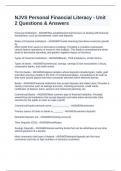NJVS Personal Financial Literacy - Unit
2 Questions & Answers
Financial Institutions - ANSWERan establishment that focuses on dealing with financial
transactions, such as investments, loans and deposits
Roles of Financial Institutions - ANSWERProvide financing that drives economic growth
by
Move funds from savers to borrowers (Lending). If lending is curtailed, businesses
cannot finance operations or invest in new projects. This leads to unemployment which
leads to decreased spending, and greater negative impact on business
Types of Financial Institutions - ANSWERBanks, Thrift Institutions, Credit Unions
Types of banks - ANSWERcommercial, savings, savings & loan associations ( S&Ls),
cooperative banks, and credit unions
The first banks - ANSWERreligious temples where deposits included gram, cattle, gold
and other precious metals in the form of compressed plates. Considered to be safe as
they were sacred places that were constantly attended which deterred thieves
Banks - ANSWERFinancial institutions that accept deposits and make loans. Provides a
variety of services such as savings accounts, checking accounts, credit cards,
certificates of deposit, loans, pension and retirement planning, etc.
Commercial Banks - ANSWERMost common type of financial institution. Privately
owned financial institutions that accept deposits and make loans and provide other
services for the public in order to make a profit.
Commercial banks primarily serve_____________ - ANSWERbusinesses
Primary source of funds to banks is _______ - ANSWERcustomer deposits
Demand Deposits are - ANSWERchecking accounts
Time Deposits (CDs) - ANSWERcertificates
Savings Deposits - ANSWERinterest-earning funds that can be withdrawn at any time
without payment of a penalty
Most commonly used type of deposit - ANSWERdemand deposits are the most
commonly used due to high numbers of business customers
,Federal Reserve System - ANSWERThe country's central banking system, which is
responsible for the nation's monetary policy by regulating the supply of money and
interest rates
Federal Deposit Insurance Corporation (FDIC) - ANSWERthe government agency that
insures customer deposits if a bank fails
covers most types of accounts such as checking, savings, certificates of deposit up to
$250,000 per person, per bank
since established in 1934, no one has ever lost money in an account at a failed FDIC
insured bank
Thrift Institutions - ANSWERFinancial institutions that obtain the majority f their money
from the savings of the public. Originally developed to provide services for thos ignored
by commercial banks
Primary types of Thrift Institutions (Thrifts) - ANSWERsavings and loan associations,
mutual savings banks, and credit unions
First Savings banks - ANSWERfounded in the 1800s to provide a place for blue collar
workers, clerks, domestic workers to save for a "rainy day"
First Savings and loan and cooperative banks - ANSWERfounded in the 1800s to help
factory workers and other wage earners a way to become homeowners. S&Ls accepted
savings deposits and provided loans to home buyers not welcome at traditional banks
due to their low income
Credit unions were established in __________ to ______________ - ANSWER19th
century, to provide emergency funds to people unable to borrow from traditional
lenders. Started by people who shared a common bond and pooled their money to
make small loans to one another (i.e. family, neighbors, co-workers)
Credit Unions - ANSWERNonprofit financial institutions owned and operated by
members, that offer the full variety of banking services to their members.
You can buy a membership to a credit union by ____________________ -
ANSWERmaking a deposit with the credit union
Decisions in a credit union are made by _________________ - ANSWERthe Board of
Directors (elected members of the credit union)
Credit unions often offer rates that are different than banks. The
include_____________________ - ANSWERlower loan rates, higher savings rates,
lower costs or free services
, Credit union membership is ________________ - ANSWERrestricted to person sharing
a common bond ( i.e. employees of corporations, members of associations, residents of
defined areas, etc)
Credit unions are regulated by __________________ - ANSWERNational Credit Union
Association (NCAU)
lending institution - ANSWERa financial organization that provides loans. Divided into
two categories depository institution (banks) and non-depository institutions (non-banks)
Examples of Non-depository Institutions (non-banks) - ANSWERbrokerage firms,
mutual funds companies
The bank is a _______________, for profit - ANSWERbusiness
What happens to your deposit? - ANSWERMoney is added to the existing balance in
your account and recorded
Your money is added to all the other deposits for the day
Part of the money is set aside in a reserve
Much of the rest is loaned to people requesting loans from the bank
How does interest work at the bank to make the bank money? - ANSWERFor interest
bearing accounts, The bank pays account holders extra money (interest) for depositing
their money in specific accounts (i.e. 1%)
When the bank provides loans to customers, they charge the borrower a high rate of
interest (i.e. 8%)
The bank keeps the difference between what they charge the borrower (i.e. 8%) and
what they pay depositors (i.e. 1%)
example: 8% - 1% = 7% that goes directly to the bank
Interest rates depend on________________ and ______________ - ANSWERHow
many people want to borrow money
How much money banks have available to lend
If the bank has a lot of money and loan demand is low, then interest rates will be
___________ to _____________ - ANSWERlow
attract borrowers




